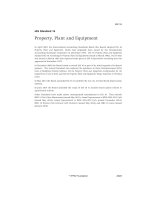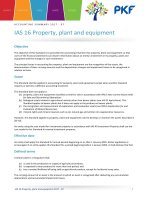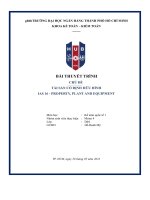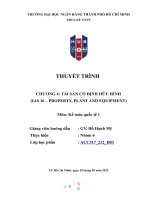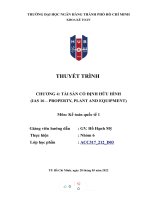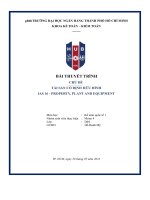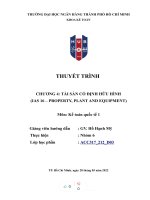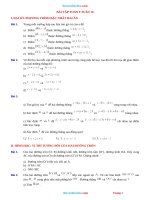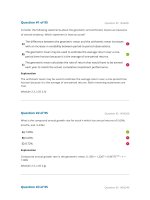IAS 16 — property, plant and equipment
Bạn đang xem bản rút gọn của tài liệu. Xem và tải ngay bản đầy đủ của tài liệu tại đây (472.71 KB, 49 trang )
IAS 16
PROPERTY, PLANT AND EQUIPMENT
Presented by :
th
March 8 , 2019
OVERVIEW
Objective and scope
Recognition
Initial Measurement
Subsequent Measurement
Measurement after recognition (CM, RM)
Derecognition
Disclosure
OBJECTIVES
Timing of the recognition of assets
Determination of assets carrying amounts using both the cost model and the revaluation model
Depreciation charges and impairment losses to be recognized
Disclosure requirements
SCOPE OF THE STANDARD
IAS 16 applies to the accounting for property, plant and equipment, except where another
standard requires or permits differing accounting treatments.
SCOPE OF THE STANDARD
SCOPE OF THE STANDARD
IAS 16 applies to all PPE except
Assets Held for Sale and Discontinued Operations (IFRS 5)
Biological assets (IAS 41)
Exploration and evaluation assets (IFRS 6)
Investment Property (IAS 40)
Mineral rights and mineral reserves such as oil, natural gas and similar
non-regenerative resources.
DEFINITION : PROPERTY, PLANT & EQUIPMENT
Property, Plant & Equipment defines Property Plant and Equipment as tangible assets
that -
Held for use in the production or supply of goods or services for rental to others, or
administrative purposes
Expected to be utilized in more than one period.
OTHER IMPORTANT DEFINITIONS
Cost:
Cost is the amount of cash and cash equivalent paid to acquire an asset at the time of its acquisition and construction.
Fair Value:
Fair value represents the present market price of an asset.
Carrying amount:
Carrying amount is the amount at which an asset is recognized after deducting any accumulated depreciation of losses.
Formula:
Carrying amount = Acquisition cost – Accumulated Depreciation
MEASUREMENT of RECOGNITION
An item of Property, Plant & Equipment that qualifies for recognition as an asset shall be measured at its cost
Element of Cost:
Its purchase price and duties paid
Directly attributable costs
Initial estimate of the cost of dismantling and removing the item and restoring the site
Materials, labour and other inputs for sell constructed assets.
MEASUREMENT of RECOGNITION
Items of property, plant, and equipment should be recognised as assets when it is probable that:
It is probable that the future economic benefits associated with the asset will flow to the entity.
The cost of the asset can be measured reliably.
MEASUREMENT at RECOGNITION
COST NEVER TO BE CAPITALIZED
Costs of opening the facility
Costs of introduce new product or service
Costs of conducting business in the new location or with new class of customer
Administration and other general overhead costs
Costs incurred in using or redeveloping an item
Amounts related to certain incidental operations.
MEASUREMENT at RECOGNITION
EXAMPLE of initial measurement
DAF bought a new printing machine. The cost of the machine was $80,000. The costs to delivery from supplier were
$3,000.The installation costs were $5,000 and the employees received training on how to use the machine, at a cost of
$2,000. Before using the machine to print customer’s orders, a test was undertaken and the paper and ink cost $1,000.
What should be the cost of the machine in the company’s statement of financial position?
Solution
Cost of machine:
Cost
: $80,000
= $80,000+$3,000+$5,000+$1,000
Delivery cost
: $3,000
= $89,000
Installation costs: $5,000
Training cost
: $2,000
Test cost
: $1,000
MEASUREMENT at RECOGNITION
Note:
Following elements of cost will not become the part of the cost of asset and will be charged to statement of profit or loss as expense:
- Insurance cost
- Labor training cost
- Rectification cost of an error
- Cost of initial operating losses
- Start up cost
- Relocation cost
- Cost related to opening of new facility
- Any general and administrative overheads
MEASUREMENT at RECOGNITION
Self-constructed
Apply same principles: The cost of a self-constructed asset is determined using the same principles as for an acquired asset.
If an entity makes similar assets for sale in the normal course of business, the cost of the asset is usually the same as the cost of
constructing an asset for sale (see IAS 2).
It will be the sum of Material, Labour and Overhead cost of such asset.
. Charge abnormal costs to P or L: Any cost of abnormal wasted material, labour or other resources will be charged
to statement of profit or loss as expense.
. Interest costs during construction: IAS 23: «Construction Period Interest should be capitalized (based on
weighted average of accumulated expenditures) as part of the cost of producing PPE.
.
Government assistance: IAS 20
MEASUREMENT at RECOGNITION
Self-constructed
At 1 Jan,2018 DAF started to contruct a new machine for production. The following costs were incurred on the construction:
Materials
$30,000
The machine was completed on 1 Oct 2018 and started producing on 1 Jan,
2019. DAF issued a $50,000 unsecured loan on 1 Jan,2018 to aid construction of
Direct labour costs
$20,000
the new machine (which meets the definition of a qualifying asset per IAS 23).
The loan carried an interest rate of 10% per annum and is repayable on 1 Oct
Installation costs
$7,000
2019.
Required:Calculate the amount to be included as property, plant and
Testing cost
$3,000
General overheads
$6,000
equipment in respect of the new machine.
MEASUREMENT at RECOGNITION
Self-constructed
Solution:
Determine: Expense can be capitalized?
How should we do with interest on the loan?
Materials
$30,000
Direct labour costs
$20,000
Installation costs
$7,000
Testing cost
$3,000
Borrowing costs
$5,000
Total to be capitalized
$65,000
MEASUREMENT at RECOGNITION
Exchange of asset:
If non-monetary transaction, exception to FV principle if:
1.
FV cannot be reliably determined, or
2.
Transaction lacks commercial substance – i.e., transaction has no economic effect on the entity
MEASUREMENT at RECOGNITION
Commercial substance exists if:
Cash flows (amount, timing, risk) of new asset differ from those of old asset(s) transferred; or
After-tax cash flows of part of business taking on new asset (entity specific value) have changed; and
Difference in 1 or 2 is significant
MEASUREMENT at RECOGNITION
Exchange of asset:
Company A exchanged machine A with machine B from Company B.
Machine A’s carrying amount at the date of the exchange was $10,000, and its fair value was $15,000. The manner in which the exchange is
accounted for depends on whether or not the transaction had commercial substance.
Therefore, the Company’s ledger entry for the transaction will be as
Assumption A – Transaction with commercial substance
Dr PPE (machine B)
Cr PPE (machine A)
Cr Gain on disposal of machine
$15,000
$10,000
$ 5,000
Assumption B - Transaction without commercial substance
Dr PPE (machine B)
Cr PPE (machine A)
$10,000
$10,000
SUBSEQUENT RECOGNITION
Additional costs are incurred after the asset becomes operational is called subsequent costs.
For example:
Expense day-to-day servicing cost.
Repair and maintenance, overhauling, upgradation, replacement costs.
MEASUREMENT after RECOGNITION
IAS 16 permits two accounting models for measurement of the asset in periods subsequent to its recognition.
Depreciate
Cost model
cost over
useful life
Depreciate
Revaluation
Model
Revaluation
revalued
amount over
useful life
COST MODEL
Carrying amount = at cost – accumulated depreciation – accumulated impairment losses
Notes:
Under the cost model, the impairment is always recognized (debited) as expense
Dr Expense
Cr Accumulated Impairment loss
REVALUATION MODEL
Carrying amount = Fair value – subsequent accumulated depreciation – subsequent accumulated impairment losses
MEASUREMENT after RECOGNITION
COST MODEL (CM)
Depreciation
Each major component may have a different depreciation policy
Depreciable amount: carrying amount less residual value
Residual value: estimate of net amount entity would receive now from asset’s disposal, if asset was as old and in same condition as expected at end of its
useful life
MEASUREMENT after RECOGNITION
COST MODEL (CM)
Depreciation (continued):
Depreciation period begins when PP&E is in place and ready to use, continues even if not used or is retired from active use.
Depreciation period ends when PP&E is derecognized or classified as held for sale (IFRS 5).
Depreciate over useful life to entity.
MEASUREMENT after RECOGNITION
COST MODEL (CM)
Depreciation (continued):
Depreciate over useful life to entity
Useful life – consider capacity, wear and tear, technology changes, changes in product demand, contractual or legal limits.
Choose method based on pattern that asset’s economic benefits are expected to be received: SL, DB, or activity-based
If change in pattern, change method prospectively (change in estimate)
Note
Dr Depreciation expense
Cr Accumulated depreciation
